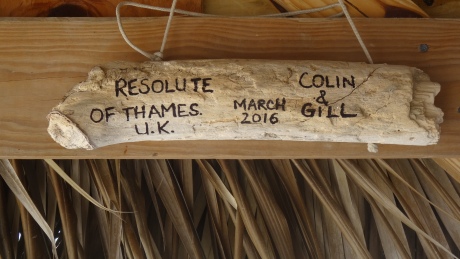
Our plaque exhibited in the ‘yacht club’ Hog Bay, Ragged Island.
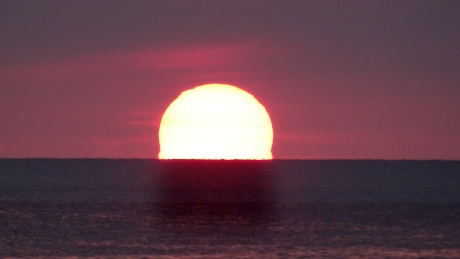
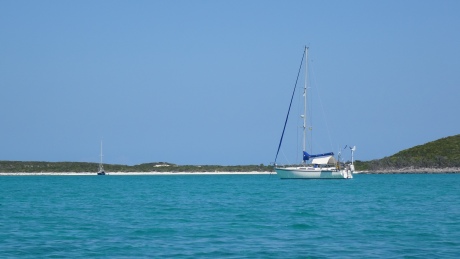
Yes, honestly, THIS blue!
It is shameful and I have very little by way of excuses for not writing any blog since May. Yes, there have been pauses on my personal journey due to illness and the miles have been covered towards Blighty with vigour and vehemence – so perhaps you will forgive me?
I left you stranded dear Reader (if any such still exist) off Cuba with high expectations for the blue, luxuriant beyond of the Bahamas. Oh how blue and luxuriant they proved to be, especially by comparison to the often dull monotony of Communist Cuba. What did not change in both destinations was the warmth of the islanders and their pride in their very separate homelands.
It would be an untruth to say that we left Cuba regretfully. We are far too attuned to all the niceties our Capitalist-rich society can provide and were becoming desperate for the easy comfort of well-stocked grocery stores not to mention the freedom to go as we please. It is still astounding to think that Cubans have known none of this. To them our well-stocked, choice-laden shops would seem excessive and wanton and perhaps they have a point. But as to their freedom to do as they please? I suspect they would find some insecurity in that. Perhaps too much individual responsibility for their own well-being and success in a free society would be onerous – I tend to think so.
We had heard so much about the Bahamas – not all of it positive. Our weather guru, Chris Parker, was often to be heard in his broadcasts, gleefully warning of grim ‘weather events’ thereabouts – the like of which we had never experienced in the Caribbean. No safe trade winds here to rely on then – winds and seas came from every which-way depending on the US lows and highs. As a huge archipelago (100,000 square miles) of low lying coral islands and reefs there was often little protection to be had. In fact some of our friends had experienced first hand the wrath of a tropical storm from the minimal shelter of a horseshoe of coral island first hand the previous season, which had caused severe damage both to their boat and to their morale. So it was with some trepidation that we headed north away from Cuban shores. But all that time at enforced anchor in strange Cuban bays had given us time to study the Bahamas well in advance (thanks too to the generosity of OCC friends who letd and give us books and charts) including listings and mapping off all the safe, protected bays and harbours available to us in case of bad weather. Thousands of others do it…..so Ragged Island, the southern-most island in the Jumentos chain was to be our first Bahamian encounter – here we come!
The water colour and depth changed inexorably as we completed our 80 mile trip. At dusk on that first day the only clue that there was any land ahead were some twinkling lights coming on as dusk fell. We had not quite managed to reach our intended destination – the anchorage, attractively called Hog Cay off Ragged Island by nightfall (at about 7ish – slightly later than in the southern Caribbean where nightfall was always dead on 6). Tantalisingly, we could see the boats anchored in the Cay just over there – but we could not risk making our first passage through the very shallow reef in the dark. Every book and every experienced sailor of these parts makes it clear that the coral reefs are alive and changing all the time. There was no substitute then for actually ‘eyeballing’ your way through even the most tried and tested routes through the reefs. Not to be rude about our beloved vessel, but Resolute has a big bottom – what I mean is that she is a lovely stable, solid old girl because she has nearly 2 metres of keel under the water. However, in the shallow reefs of the Bahamas this was not an asset. The shallow draught catamarans always had the edge – flitting hither and thither wherever they pleased whilst we watched our depth gauge like hawks whilst holding our breath and stuck like limpets to known routes through the coral. You get the picture. So our first night in the Bahamas was spent at anchor (being careful not to put the hook down on the coral so as not to damage it in any way) in a very scary mere 3 metres of the clearest, bluest water imaginable in spitting distance of the anchorage for which we were destined.
Of course, in the clear light of the next bright morning, we were able to feel our way extremely cautiously through the reef – beginning to differentiate the shades of blue which were the key to discerning the relative depth. We eventually joined several fellow equally intrepid depth-watcher yachties (and many more of those despised carefree catamarans) in Hog Bay. We had at last arrived! We languished there at anchor in oodles of crystal clear azure water – well about 4 metres – which as we were fast learning was indeed oodles.
The land itself was yes, low-lying, lava-ish and unattractive scrub land, with no habitation in sight. The only nod to human visitation was n the beach area where an impromptu beach bar had been erected out of driftwood, salvage and the odd additional rejected boat seat or folding chair or table under a canopy of dried grass. When we dinghyed ashore we could see the finer detail of the place: it was grandly labelled ‘The Yacht Club’ and it seemed that every visiting yacht had left a home-made name plate of some description at this far-flung outpost. We in turn left ours several days later. This was not owned by anyone, just a makeshift facility added to over many seasons by visiting yachts. As we gleaned over the several days we were there – good use was made of it….one evening even a children’s birthday barbecue supper was hosted there with a hung sheet providing movie entertainment for the children….don’t you just love the Americans!
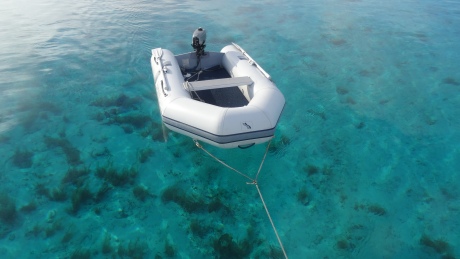
THIS BLUE!
But whilst this was part of the ‘away from it all’ idyll so characteristic of these remote islands in the Bahamas, we were anxious to find some other-than-Cuban civilisation and commerce. The small habitation of Duncan Town was a long, long dinghy ride away, tucked into the adjoining island down a hidden straight causeway. Off we went, armed with extra fuel and water supplies in our trusty little dinghy, just praying that our diminutive 2.5 horsepower outboard, known for its outbursts of truculence would today behave. We set off into the wide blue yonder, seeing at close quarters just how shallow the surrounding area could be. At one point skipper got out of the dinghy and hauled it across the shallows (these sharp coral heads could do for a hypalon dinghy floor in no time so needed to be treated with respect). The waters were crystal clear, allowing us to see the entire ecosystem under the water: teaming with dodging little psychedelic fish of all shapes and sizes; peachy and purply coral encrusting or wafting every rock and crevice; shy turtles popping their heads up, with tendrils of sea-grass trailing from their mouths, ensuring we were safely past before resuming their sea-bottom grazing; star fish littering the sea-floor like carefully placed decorations on a colourful carpet. To those who snorkel and scuba-dive these sights are fairly common-place and carefully catalogued throughout the Caribbean, with the Bahamas considered diving Nirvana , but Colin is no scuba-diver (although he does snorkel) and Gilly is not a water-baby at all, so our first dinghy-ride across this incredible sea-scape was literally awesome for us. We temporarily forgot our main mission as we gawped and exclaimed at the view below. Eventually we focused enough to find the narrow hidden channel which leads to Duncan Town. In the distance we could now see some buildings. Coming in the other direction we met some local speed boats, presumably off out fishing and dipped out of their well-steered way with smiles and waves. On we chugged with the distant buildings growing along with our curiosity. Eventually the channel opened up into a bay littered with little fishing boats of all descriptions, wooden docks and a small slip way. We pulled the dinghy up the slip and fastened it off. There was no-one around and the place was quietly baking in the morning heat. We walked up a steep path to the road and headed towards the biggest buildings. From this elevated position the outlook of the surrounding waters were breath-taking – a surreal blur of impressionist smudges of hues of blue. We ventured into a grand-styled pink building which announced itself grandly on the official sign outside as ‘Government Building’. Inside it was cool and silent but our footsteps were answered by some others coming nearer and eventually the smiling face of a lady who introduced herself as Charlene greeted us. She was excited to hear we were from Europe, even more excited to hear we were from the UK as most of the visitors here were American. No, she informed us, we could not officially clear in here. That would probably have to wait she said until we got to Long island many miles to the north……but not to worry, everyone was laid back about that sort of thing here. Yes, she said there was a grocery store called Maxines which would probably be fairly well stocked at the moment she added as the mail boat had quite recently called – the island’s only connection for goods, supplies and of course mail….but it was soon to shut for lunch and don’t forget too to visit Angie’s a little further down the main (and only) road for a hand-made souvenir . Armed with this new information we hurried to find Maxine’s full of excitement for our first grocery re-supply outside of Cuba for over 2 months. To our dismay, we couldn’t immediately find Maxine’s as we, silly us, were looking for a shop-front. No, Maxine’s was just a side door in a little house and the shop itself took up two little rooms crammed with everything from chewing gum to rat-poison. Lacking was any fresh or frozen protein. Ever hopeful Colin lifted the creaking lid of a rusty chest freezer and inside was delighted to find it full of fish and lobster. Maxine , though friendly enough in a reserved behind-the-counter sort of way, was not given to unnecessary conversation, so when Colin excitedly enquired how much the lobster and fish were in the trove he had found she dismissed him with a shake of her head saying those were not for sale. Crest-fallen, we got excited instead about an upright fridge which contained chilled fruit and vegetables of a kind we had not seen for a long while – potatoes (yes, potatoes!) tomatoes, grapefruit, even grapes. There was also UHT milk (joy of joys!), Cadbury’s chocolate, eggs, tins of American delights, cookies and crackers…..oh the extravagance of it all! Maxine was pleased that we spent a tidy number of US dollars in her establishment and reminded us as we left to be sure to visit Angie’s…..so we went down the road a little to find the lady herself on a chair on her stoop waiting for us. She opened the door to her little emporium and chatted to us about life on this tiny island, pointing out the salt pile out of her window which, she explained used to be the mainstay of the island’s economy, especially when nearby pre-revolutionary Cuba used to exchange their salt for fresh produce. Now the trade was limited but salt was still produced. We bought some of course along with some beautiful souvenirs hand made from shells and driftwood. Again, Angie was pleased to have served us and went back to her stoop…patiently awaiting the next passing tourists.
There being no other excitements, we headed back along the road, past a shack with animal skins (goats I think) drying outside and a large, noisy pigeon aviary (supplying live protein for the times the mail-boat was late or the rusty freezer was empty we presumed). Down the steep path to patiently waiting dinghy. Back down the channel into the vast blue expanse once again. On our way back we passed a rock with a large cross atop it. Apparently this commemorated the demise of a poor Anglican Bishop in the 18th century whose boat hit the rock or the surrounding reef– now called Bishop’s Rock of course.
We were pleased to get back to Resolute after what had been the longest dingy ride we had ever attempted – thankfully without a problem. We enthusiastically unloaded our haul of treasure and stowed it all proudly in our depleted lockers. We were definitely back in the Land of Plenty – well, on the Ragged fringes anyway.
As we have explained before, our Ocean Cruising Club burgee broadcasts to anyone who might be interested that we are members. We were aware that our American cousins take their membership of the OCC very seriously. This was proved when Nancy and George dinghied over to us to say hello and invite to drinks at the ad hoc ‘yacht club’ on the beach. Nancy and George hail from Florida and make their pilgrimage every year through the Bahamas and down to the Raggeds, They are so familiar with it all they were asked to contribute to one of the foremost pilotage guides to the southern Bahamas. What a delight it was for us the apprehensive newcomers to listen to the oh-so experienced couple in a similar vessel to ours,who had been there and done it and got the T-shirt. To say we exchanged information would not be honest: over the next few days we bled them dry of all the information they could offer us about every aspect of sailing in the Bahamas. George playfully scoffed at our trepidation to cross the dreaded shallows of the Comer channel from the top of the Jumentos to Long Island…..most of the time, he insisted it was more than the charted 2.4 metres……oh that’s OK then we nervously chuckled….. knowing we need 1.9 metres in flat water absolute minimum to stop us going aground! It felt a real privilege to glean so much knowledge about the area in so short a time from a couple who were so generous with their information. The privilege was compounded before we said our sad farewells when Nancy and George invited us on a very special walk on the island. It was a trail (path) across Little Ragged Island which George and a fellow OCC member had cut several years beforehand and still existed as a glorious walk from the cobalt-shaded reef one side to the equally spectacular blues of the other side. The trail is a lasting legacy on the island to be enjoyed by all who visit. Having exchanged some Lady Grey tea (which Nancy loved – oh, so adorably English!) for some delicious banana bread, it was time for us to head north before a nasty blow approached. Nancy and George were of course not running for cover – they were nonchalantly going to sit it out, as they had many times before. Cool as you like.
The rest of the Jumento islands are mainly uninhabited and unspoilt. They are a croissant-shaped, 110 mile chain where it looks as if the long reef has occasionally popped a plateau or two of scrub up above the water to take a breather. The spectacular waters are the main event hereabouts it seems. Whatever the landscape, it was pretty wonderful to be sailing with just our headsail flying past these little bits of land in this shallow, azure channel, occasionally passed by other mainly American boats heading down to the Raggeds. We really felt free again. We always have our VHF radio on channel 16 in case of any emergency contact but were surprised to be hailed whilst so far away from anyone else….well we presumed it was us they were hailing….as the drawling American voice asked for “the sailing boat just passed us”. Skipper tentatively answered in his best British no nonsense accent…”er, yes, this is Resolute….were you calling us?”. “Why yes”, said the drawl “boy you looked mightee pretty when y’all just passed us…we wanted to tell ya….!” “Er…..yes, very kind…”,.hesitated Skipper with his reply. Something had just literally told us we were definitely in a totally different country!
We spent one night anchored in Flamingo Cay alongside many other boats traversing the same route. As we were quickly learning, in the Bahamas for boats of any draft, there is only one route between the islands, making this one of the only stopping places along that route. There was nothing to go ashore for but the big horseshoe bay was sheltered and calm before we set sail north again following The Route (locally called ‘cuts’) and being joined as we went by more and more fellow travelers.
When the last of the Jumentos Islands – by this point little more than rocks – faded into the blue we started to become nervous. To our port side was the Great Bahama Bank, a very shallow reef which stretches for over 50 miles between the westernmost islands of the Bahamas, known for its dangerous coral heads which dangerously poke up throughout. We were about to cut the corner of it. We had worked our timings with the tides (minimal, pansy tides – only about a meter – but absolutely crucial in these shallows) and double checked them. Here was this long channel, the Comer channel, which dear George had assured us would be passable. Some friends of ours, Judith and Ken, who themselves had crossed the entire Great Bahamas Bank through its only ridiculously shallow cut had advised us that the only way to approach them is not to constantly look anxiously at the depth gauge, but to count the starfish you can see through the transparent waters along the way. So putting our fears aside we did just that and tried to enjoy the ride in this challenging but eye-wateringly beautiful place. Unfortunately, with only a little wind that lacked a consistent direction we could not sail through the cut. George was vindicated and the answer was 5 (starfish). Once across and gratefully in some depths again we were able to joyfully sail into the shelter of Thompson Bay, just in time for the expected bad weather to arrive. Who said this sailing malarky was stress free?
Long Island is certainly that – 76 miles long in fact. It could never have been called Wide Island as it is only about 4 miles wide. What is it good for – I hear you ask? Well, apparently early settlers here used to graze livestock on the relatively fertile soil, particularly Scottish ‘black face’ sheep and thoroughbred horses. Fishing (of course) and sponging also helped fill the coffers. From the moment we first dinghyed ashore we could see something catastrophic had happened as the hotel and shops we had been promised in our pilot book were in ruins. We inquired at the little Tourist Information Centre (it was so great to be able to speak English again and be understood!) and were told the whole area had taken a battering in the hurricane season 2015. It was said as an unemotional statement of fact without any note of consternation or self-pity. This was obviously how the cookie – or the businesses -crumbled round here. We were advised that to clear in with Immigration and Customs it would be necessary for us to hire a car, so we booked one with them for the next day and were then able to head up to the tiny airport. Marvelously, we were able to clear in to the whole Bahamas archipelago in one go at the not so small charge of $300 – ouch! However, we were thrilled to be able to travel from island to island uninhibited in stark contrast to both Cuba and the Carribean. Our exploration of Long Island by car did not tell us much about it really, except that it really was, yes, long. The whole island looked down-at-heel possibly due to the damage caused by the recent storms. Clarence Town, the capital on its southern tip and exposed to the Atlantic swells and winds was the only viable harbour and small marina available to yachts, but we were very pleased we did not choose to go there as the few boats there were bobbing madly on their moorings and Clarence Town itself had very little to offer with boarded up shops and commercial premises. No, Thompson Bay had been a good sheltered spot to sit out some windy, rainy weather (thank you George). Sadly as were were still very much in our post-Cuba phase, grocery shopping was still a great excitement to us. Several times , despite the weather, we dinghyed over to the crumbling quay and walked to the little grocery store along the (only) road. There we were able to re-supply our lockers with essentials all shipped from the US and twice the price. The tiny shop was stacked floor to ceiling with goodies and we relished our time there relishing our new reality…pathetic I know! We tried to buy 2 pieces of lamb for our little freezer but were advised by the little lady at the checkout who we were getting to know quite well after several visits but who still couldn’t quite manage to smile at us in any form of re cognition, that only one joint of lamb was allowed. Oh, we said, why is that? So some of the other islanders can enjoy it was her reply! Chastened by our greed, we made a hasty retreat…with our single leg of lamb.
Next stop, once the weather had settled again, was across to the Exuma Islands and George Town, which everyone had told us was the mecca for boats in the Bahamas. Another shallow cut to follow and in behind the island we went to be confronted, as we reached the comparative metropolis of George Town harbour by hundreds and hundreds of anchored yachts! Astounding! This, George and Nancy had told us, was called Chicken Town by some as for most American sailors this is as far as they would risk going along the charted cuts and as far as they wanted to go from their idea of civilisation. Firstly, we had to find a place to drop our hook….not an easy task when there was hardly any space. Eventually, feeling many an eye was watching us suspiciously, we found somewhere which we hoped would not obstruct the local ferry which reportedly came in regularly. The VHF radio provided us with an information service radio net run by the anchored yachties. We were invited to introduce ourselves and then quite pointedly to wait until the end of the broadcast when newbies like us were collectively given the run-down of the place. We were somewhat taken aback by all that was on offer for those anchored here: everything from Alcoholics Anonymous to open-air church services; children’s clubs; conch shell blowing (I kid you not); raffia craftwork classes; quilting; fishing trips; shopping trips; hiking trips……you name it, they did it! It became obvious to us that all these yachts (called Snow Birds – as they come south from the cold northern climes) just turned up here year after year, possibly grabbed the same spot and guarded it ferociously, then set about inventing a little US township (Skipper preferred the term ‘ghetto’ ) all of their own here in the Bahamas. Exuma Island itself was subsumed under it all. As you can imagine this was not our cup of tea at all, so having joined the morning procession of about 100 dinghyies to the big US supermarket to get our grocery fix and having paid the exorbitant bill along with all the others, we decided to move on. If you asked me about the real St Georges as a town on Great Exuma Island and its people I really wouldn’t be able to tell you anything as it had been swamped by the American culture.
Onward. We couldn’t have tarried even if we had wanted to as we had arranged to meet our friends, Jenni and Paul in Nassau in a few weeks and we had the sudden realisation that with all these cuts to negotiate along with weather events to avoid and with precious few direct routes to Nassau we were going to have to get a move on. We stayed a night in a little cut, called Farmer’s Cut, between a few of the Exuma chain. Here at last we could glimpse the local culture as the whole of the area had been owned and preserved as was by one family who still ruled the roost in every possible way from flights in and out by little plane, to egg and fish supplies, hospitality and mooring balls – like the one we were tied up to whilst there.
Leaving the Exuma chain we headed north to Eleuthera – a very distinctive long (90 miles) island with a whale-like tail. It was obvious that the closer we got to the US coast, the more commercialised and tourist -aware these islands were becoming but Eleuthera had thankfully preserved some of its original spirit. There was a long walk along the shore where enterprising locals made handicrafts for sale made from the local shells, coral and driftwood selling them in little colourful huts on the road-side. A little walk inland was an lake pool of sea water 50 feet deep called the Blue Pool where local people came to swim and cool off. A perfect place to shelter from another bout of bad weather (there were almost weekly lows which lasted a few days) was Hatchet Bay – another pearl of a place which George and Nancy had shared with us. This Bay was almost impossible to find as we sailed north along the length of Eleuthera as the entrance to this large bay was very narrow and quite impossible if any significant swell was running. With our good fortune still with us we were able to navigate the entrance once we found it without any hassle – only to watch over subsequent days when the wind really increased that the entrance became virtually impassable with dangerous swell at the rocky entrance. Npw, the locals at Hatchet Bay obviously knew a thing or two about good fortune and were determined to make the best of it. There were mooring balls in the bay which our guide book told us were fee to use. We gaily tied up to one when we arrived only to be told in no uncertain terms in the local patois that in fact the buoys would cost us $30 a night. Skipper replied to the surly voice on the radio that in that case we would untie ourselves forthwith and anchor instead…..and that is just what we did! Occupants of other boats in the bay watched knowingly as we swiftly untied – we suspected they too had been had been got by what was possibly a money-making scam. From the peace of our almost totally sheltered anchorage we were able to watch quite a storm come and go – in fact it was the first time we clearly saw a water spout – a mini tornado – which thankfully gave our safe haven a wide berth. Ashore at Hatchet Bay there was little of note – a fishing village called Alice Town continues as it always has with little fanfare or nods to the tourists. We learned that Hatchet Bay was in fact a man-made. A hole was blasted through the limestone to give access for a new cattle-raising project on the island which alas did not succeed.
After watching the impressive low go through, off out through the now-settled narrow entrance we boldly ventured. The stress-point of the next chapter of our trip was Current Cut. This is a very narrow canal-like cut through the north west tip of Eleuthera….some call it The Eleutheran Panama Canal. As the name suggests, it is the current – up to 6 knots -through this cut which can prove the challenge rather than the depth – although some nice rocky outcrops make the going interesting too! Timing is of the essence. We had to be going through about 2 hours after high water to be make best use of the current. My trusty Skipper had done the calculations and double checked them so without much ado we went through the cut with about 2 knots of manageable current with us, finding ourselves safely on the other side and heading to Nassau in deep free water in no time.
Now whenever we had mentioned to our Bahamas-travelled friends that we were going to visit the capital of the Bahamas, Nassau the answer we received was always a solitary “why?”. As we approached the sky-scrapered city we began to understand their reservations. It is a huge, ungainly, ugly city sitting incongruously in the heavenly blue Bahamian waters. It sits on New Providence Island which at 20 miles long by 7 miles wide has almost completely been subsumed by Nassau. The evening we arrived, as directed, we radioed the harbour master, said where we intended to go and asked permission to enter the narrow strip of harbour….to our surprise, as this is normally a formality, access was denied. As we stood off and circled around we could understand the problem – or should that be problems – as six massive cruise liners made their slow progress out of the harbour in succession. Yes, we were certainly in full-blown Tourist Central. Eventually we managed to get into the Harbour and into our pre-booked marina quaintly called Hurricane Hole marina. It was not a misnomer – but exactly that – a round bay encircled with berths and a perfect hole for shelter from a hurricane – the risk from which was an annual reality in the Bahamas. Hurricane Hole Marina was outrageously expensive – but then so was the whole of the Bahamas. However, when we checked in in the luxuriously furnished reception office we appreciated why it was so expensive. Our berthing price included an access pass for our whole visit to the adjoining Atlantis theme park. Initially we were not overly excited by this despite the obvious excitement of the receptionist as she explained the wonders of it all. We were tired but relieved we had got to Nassau to meet Paul and Jenni with a few days in hand and against some challenging odds.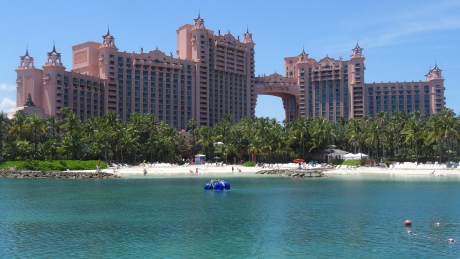
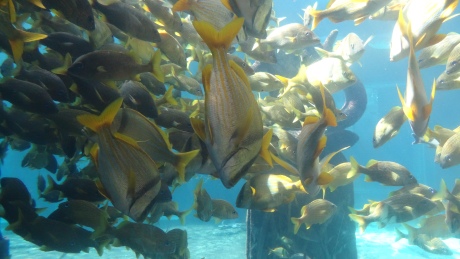
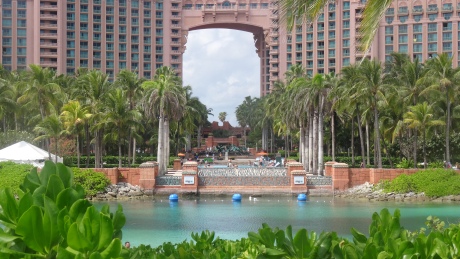
As we had a day or so to spare we decided the next day to see what this Atlantis park was all about. Alright, I know we have been a bit out touch with such attractions since our children are now grown up but we have never seen anything on the scale of this. On entering you pass through one of the several restaurant and shopping areas – everything you could possibly want to wear, style or prepare yourself for a water park and every level possible of restaurant lined behind the enormous edifices of real , completely gross motor yachts – moored as much for their celebrity value as for necessity. Then, it is a necessary, nay mandatory, part of your walk into the park to walk through a Las Vagas style casino. I know, I know, I heard you cringe just at the thought and I too cringed as I walked through this exhibition of shameless bling hosting everything from blaring flashing, enticing slot machines to roulette wheels and poker tables complete with slit-skirted croupiers. This was almost too gross to swallow at ten o’clock in the morning. Once into the actual park we were overwhelmed by an extravagance entirely as each pool we passed was inhabited by a different marine species. Here all manner, variety and vivid colour of tropical fish jostled for space with sharks and sword fish whilst shoals of sparkly, silver tiddlies rushed along with huge bass frowning and weaving at a lesuirely pace through the lot of them. We were able to observe them all from the pathways alongside the landscaped pools and from underground aquaria in massive tunnels. Other pools housed turtles and terrapins. Then on our path went to massive pools inhabited by another life form- man. One big screaming and yelping area was just for the kids with slides of different heights and speeds with a master of ceremonies holding court over various games and competitions periodically. The second pool was for us grown-ups with loungers and shades. All landscaped with artificial rocks and caves, groves and bridges. Hidden amongst these pools were rivers which on closer inspection were circuits for one to try your hand in a small boat or raft with artificial rapids and slides to contend with. Then, over a ridge the piece de resistance amongst all this edifice – was the Atlantic Ocean itself in all its glory with white fringed angry rollers making bathing impossible on the day we were there. The site was vast and surrounded by surreal and truly Disney-esque hotel towers and turrets. Our overall impression was that the place represented the meeting of Bling with Bio-diversity! We surprised ourselves by enjoying our day there immensely, promising to bring our guests – which we did, almost as soon as they arrived – ensuring they were totally jet-lagged and blinged out in one foul swoop! The taxi ride to the huge American Supermarket the next day just about did for any ideas Jenni and Paul had harboured about the Bahamas being a blissful escape from commercial hurly burly,
It was lovely to have Jenni and Paul aboard with us again. They were with us for three weeks this time with their return flight booked from Atlanta airport, USA which still seemed for all this American hype in Nassau, a long way off ….so we made tracks to the next set of islands north – the Berry Islands. These are tiny and little more than a little crescent of reefy cays some of which are privately owned whee one can glimpse private air-strips and luxury villas and beaches. Feeling the need to get back to nature we did very little off these little gem islands except snorkel, swim and relax. The swimming in the Bahamas must be done with a little caution as sharks are known to be about, but in the shallow clear waters any perils are easily seen and none passed our way. Of all the islands we had visited these seemed the most peaceful. We did spend a few nights in a friendly marina called West End Marina – another one of these enclaves where it felt many US boats took root for weeks and months – but care was taken to include us newcomers in the activities there and we enjoyed an Italian evening with them.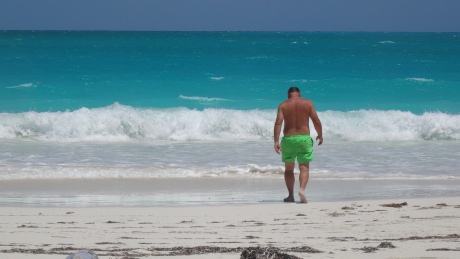
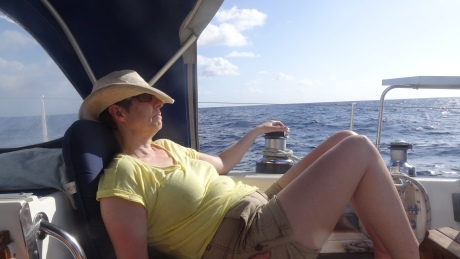
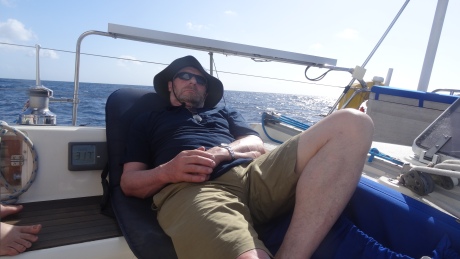
Before crossing over to the States we needed to get to the easiest (though not the narrowest) crossing point to Florida which meant us heading across to Grand Bahama Island and waiting for an appropriate weather window to cross the Gulf Stream. There are few places for yachts on this big commercial island as it is surrounded by reefs and shallows but we had reserved a place in Old Bahama Marina in West End – an ideal stepping off point. As it happened, with another low forecast we forced to spend several days in this wonderful spot. It was a lawned resort with understated blocks of luxury apartments and hotels for residents as well as restaurants and cafes. We were happy to while away a few days there basking by the pool sipping our cocktails feeling like real tourists. In addition we were treated there to a rare sight in the marina itself – a pair of manatees visited to get their fill of the fresh water they craved from hose pipes. 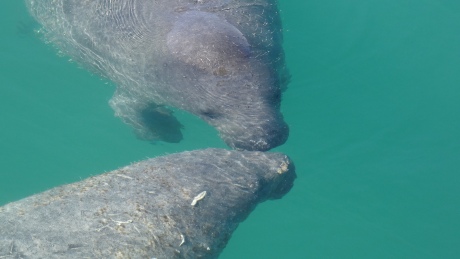 We had never seen these vast bulbous beasts before what a treat! In our hearts we knew we needed to cling on to the sight of the wonderful azure, sparkling seas. Truly the Bahamas of every poster and postcard. Perhaps what epitomised the Bahamas for us on reflection was the way that on all the islands the main road seemed to be called the Queen’s Highway with a nod to the islands British heritage but also acknowledging the huge influence that America has in what is after all their playground.
We had never seen these vast bulbous beasts before what a treat! In our hearts we knew we needed to cling on to the sight of the wonderful azure, sparkling seas. Truly the Bahamas of every poster and postcard. Perhaps what epitomised the Bahamas for us on reflection was the way that on all the islands the main road seemed to be called the Queen’s Highway with a nod to the islands British heritage but also acknowledging the huge influence that America has in what is after all their playground.
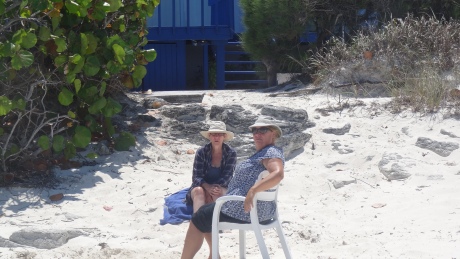
What a hard life!
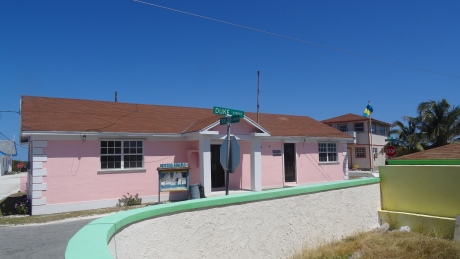
Government building Duncan Tow, Ragged Island
